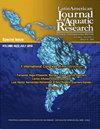Morphological variations of southern white shrimp Penaeus schmitti (Burkenroad, 1936) (Crustacea: Dendrobranchiata: Penaeidae) in natural populations of Cuba and Brazil
IF 0.8
4区 农林科学
Q3 FISHERIES
Latin American Journal of Aquatic Research
Pub Date : 2022-05-01
DOI:10.3856/vol50-issue2-fulltext-2715
引用次数: 0
Abstract
The objective of this study was to identify morphological characteristics of different populations of Penaeus schmitti Burkenroad, 1936 to contribute to its biology and conservation. In order to compare geographically isolated populations, between 2014 and 2016, selected biological variables were analyzed in six populations dispersed along the Brazilian coast and one from the Cuban coast. Specimens with eight upper rostral teeth predominated. The ordination of shrimp measurements by non-metric multidimensional scaling showed the greatest dispersion on data from Cuba, Rio Grande do Norte, and Espirito Santo, which are also the localities that presented the highest coefficient of variation. On the other hand, the values corresponding to Sergipe, Rio de Janeiro, Paraná, and Santa Catarina showed a greater similarity or clustering of the data of each location. Tail weight was estimated using length and depth of the sixth abdominal segment. The populations of Santa Catarina, Brazil (28°S), had the longest and heavier abdomens proportionally among all the compared populations, while the organisms of Manzanillo, Cuba (20°N), had proportionally shorter abdomens and the narrowest cephalothorax. The regression equation indicated a positive allometric growth for P. schmitti, and the largest total length reported for genus Penaeus in the natural environment corresponded to a P. schmitti specimen. This information could be useful in future taxonomic studies to correctly identify the species and its morphological variability. Color differences were also observed, with white ventral spots in the sternite XIV of some females from Brazilian populations, which was not previously reported in the literature. Extending these studies is recommended to contribute to the conservation and culture of P. schmitti.南美白对虾Penaeus schmitti(Burkenroad,1936)(甲壳纲:松鳃亚目:对虾科)在古巴和巴西自然种群中的形态变异
本研究的目的是确定schmitti Burkenroad对虾(1936)不同种群的形态特征,为其生物学和保护做出贡献。为了比较地理上孤立的种群,在2014年至2016年间,对分布在巴西海岸的六个种群和一个来自古巴海岸的种群的选定生物变量进行了分析。样本中有8颗上颌齿占主导地位。通过非度量多维尺度对虾的测量排序显示,古巴、北里奥格兰德州和圣埃斯皮里图州的数据差异最大,这些地区也是变异系数最高的地区。另一方面,Sergipe、Rio de Janeiro、Paraná和Santa Catarina对应的值显示出每个位置的数据具有更大的相似性或聚类性。根据第六腹部的长度和深度估算尾部重量。在所有比较种群中,巴西圣卡塔琳娜(28°S)种群的腹部按比例最长、最重,而古巴曼萨尼约(20°N)的生物则按比例较短,头胸最窄。回归方程表明,schmitti对虾正异速生长,据报道,在自然环境中,Penaeus属的最大总长度对应于schmitti龙虾标本。这些信息可能对未来的分类学研究有用,以正确识别该物种及其形态变异性。还观察到了颜色差异,巴西种群中一些雌性的胸骨XIV上有白色腹侧斑点,这在以前的文献中没有报道。建议扩大这些研究范围,以促进施密蒂P.schmitti的保护和培养。
本文章由计算机程序翻译,如有差异,请以英文原文为准。
求助全文
约1分钟内获得全文
求助全文
来源期刊

Latin American Journal of Aquatic Research
FISHERIES-MARINE & FRESHWATER BIOLOGY
CiteScore
1.70
自引率
10.00%
发文量
44
审稿时长
4-8 weeks
期刊介绍:
Latin American Journal of Aquatic Research- LAJAR is the continuation of the journal Investigaciones Marinas (1970-2007) and is published since 2008 by the Escuela de Ciencias del Mar, Facultad de Ciencias del Mar y Geografía of the Pontificia Universidad Católica de Valparaíso. LAJAR is an “Open Access” journal that publishes in English language, original research articles, reviews and short communications on aquatic science, which contain the results of research conducted in aquaculture or in oceanic and coastal marine waters of Latin America.
The following topics are considered: Physical Oceanography, Chemical Oceanography, Marine Biogeochemistry, Marine Pollution and Toxicology, Marine Geology and Geophysics, Biological Oceanography, Fisheries and Aquaculture.
 求助内容:
求助内容: 应助结果提醒方式:
应助结果提醒方式:


